1999 DODGE RAM lock
[x] Cancel search: lockPage 630 of 1691

TROUBLE SHOOTING
NOTE: To trouble shoot mechanical engine components, see
appropriate table in TROUBLE SHOOTING article in GENERAL
INFORMATION.
REMOVAL & INSTALLATION
CAUTION: When battery is disconnected, vehicle computer and memory
systems may lose memory data. Driveability problems may exist
until computer systems have completed a relearn cycle. See
COMPUTER RELEARN PROCEDURES article in GENERAL INFORMATION
before disconnecting battery.
NOTE: For installation reference, label all electrical connectors,
vacuum hoses and fuel lines before removal. Also place mating
marks on engine hood and other major assemblies before
removal.
FUEL PRESSURE RELEASE
CAUTION: Fuel system is under pressure. Pressure must be released
before servicing fuel system components.
Gasoline
1) Disconnect negative battery cable. Loosen fuel tank cap to
release tank pressure. Press on filler tube flap to relieve any
additional tank pressure.
NOTE: Fuel filler tube has spring-loaded flap located below fuel
fill cap to serve as secondary seal if fuel fill cap is not
tightened. It is part of EVAP monitor system when vehicle is
equipped with leak detection pump (LDP). Vehicle may be
equipped with flap installed into fuel filler tube even if
vehicle is NOT equipped with LDP and EVAP monitor system.
2) Remove fuel pump relay from Power Distribution Center
(PDC). For location of relay, refer to label on underside of PDC
cover. Start and run engine until it stalls. Attempt restarting engine
until it will no longer run.
3) Unplug connector from an injector. Attach one end of a
jumper wire (18 gauge or smaller) with alligator clips to either
injector terminal. Connect other end of jumper wire to positive side
of battery. Connect one end of a second jumper wire to remaining
injector terminal.
WARNING: Powering an injector for more than a few seconds will
permanently damage injector.
4) Touch other end of second jumper wire to negative terminal
of battery for no more than a few seconds. Place a rag below fuel
line. Disconnect quick-connect fitting at fuel rail. See FUEL LINE
DISCONNECT FITTINGS. Return fuel pump relay to PDC.
Compressed Natural Gas Fuel Tube Purging (5.2L)
1) Close control valve (clockwise) on all fuel cylinders.
Open manual shutoff valve (open when handle is parallel to fuel
tubes).
2) Start and operate engine until it runs out of fuel.
Attempt 3 more engine starts. If check valve or fuel fill receptacle
Page 631 of 1691
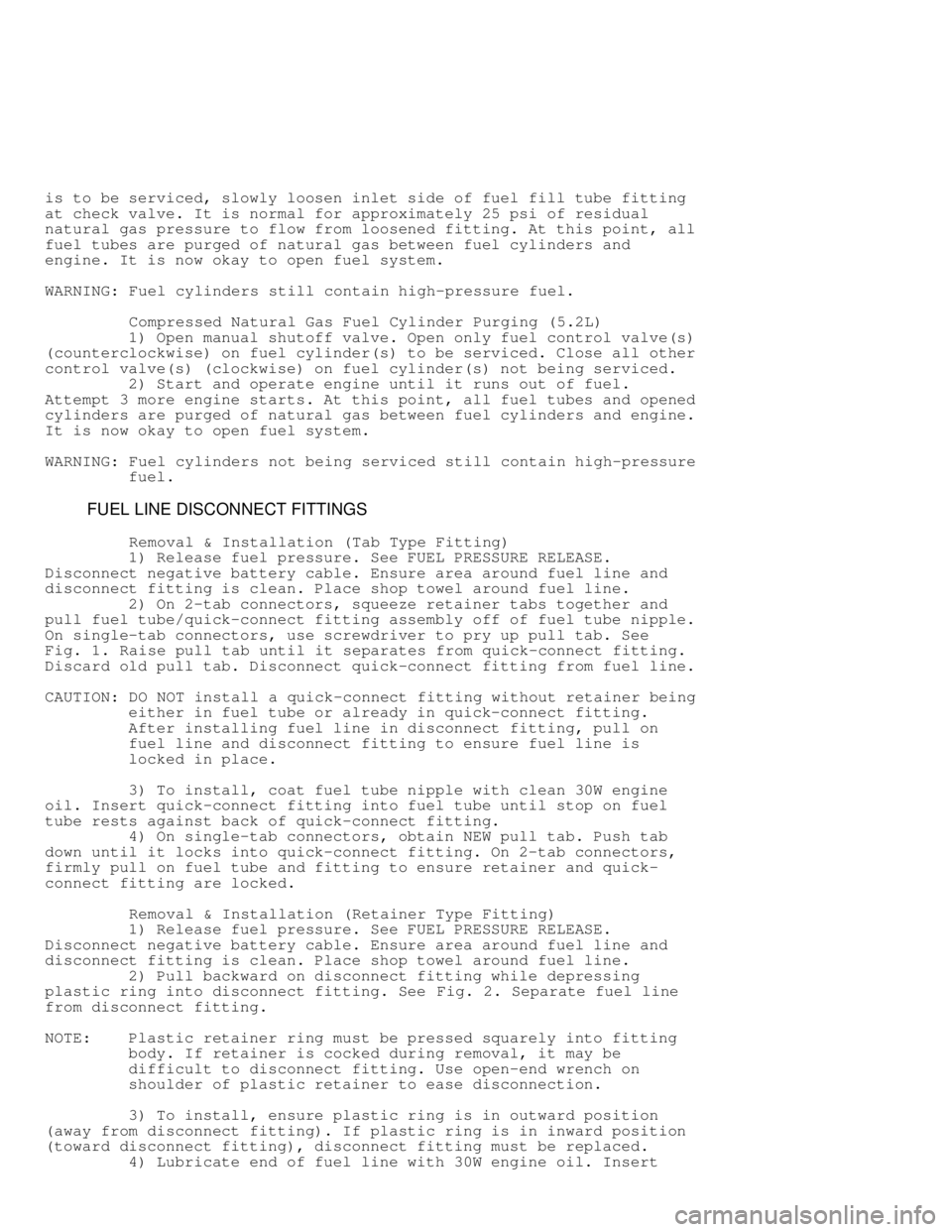
is to be serviced, slowly loosen inlet side of fuel fill tube fitting
at check valve. It is normal for approximately 25 psi of residual
natural gas pressure to flow from loosened fitting. At this point, all
fuel tubes are purged of natural gas between fuel cylinders and
engine. It is now okay to open fuel system.
WARNING: Fuel cylinders still contain high-pressure fuel.
Compressed Natural Gas Fuel Cylinder Purging (5.2L)
1) Open manual shutoff valve. Open only fuel control valve(s)\
(counterclockwise) on fuel cylinder(s) to be serviced. Close all oth\
er
control valve(s) (clockwise) on fuel cylinder(s) not being service\
d.
2) Start and operate engine until it runs out of fuel.
Attempt 3 more engine starts. At this point, all fuel tubes and opened
cylinders are purged of natural gas between fuel cylinders and engine.
It is now okay to open fuel system.
WARNING: Fuel cylinders not being serviced still contain high-pressure
fuel.
FUEL LINE DISCONNECT FITTINGS
Removal & Installation (Tab Type Fitting)
1) Release fuel pressure. See FUEL PRESSURE RELEASE.
Disconnect negative battery cable. Ensure area around fuel line and
disconnect fitting is clean. Place shop towel around fuel line.
2) On 2-tab connectors, squeeze retainer tabs together and
pull fuel tube/quick-connect fitting assembly off of fuel tube nipple.
On single-tab connectors, use screwdriver to pry up pull tab. See
Fig. 1 . Raise pull tab until it separates from quick-connect fitting.
Discard old pull tab. Disconnect quick-connect fitting from fuel line.
CAUTION: DO NOT install a quick-connect fitting without retainer being
either in fuel tube or already in quick-connect fitting.
After installing fuel line in disconnect fitting, pull on
fuel line and disconnect fitting to ensure fuel line is
locked in place.
3) To install, coat fuel tube nipple with clean 30W engine
oil. Insert quick-connect fitting into fuel tube until stop on fuel
tube rests against back of quick-connect fitting.
4) On single-tab connectors, obtain NEW pull tab. Push tab
down until it locks into quick-connect fitting. On 2-tab connectors,
firmly pull on fuel tube and fitting to ensure retainer and quick-
connect fitting are locked.
Removal & Installation (Retainer Type Fitting)
1) Release fuel pressure. See FUEL PRESSURE RELEASE.
Disconnect negative battery cable. Ensure area around fuel line and
disconnect fitting is clean. Place shop towel around fuel line.
2) Pull backward on disconnect fitting while depressing
plastic ring into disconnect fitting. See Fig. 2. Separate fuel line
from disconnect fitting.
NOTE: Plastic retainer ring must be pressed squarely into fitting
body. If retainer is cocked during removal, it may be
difficult to disconnect fitting. Use open-end wrench on
shoulder of plastic retainer to ease disconnection.
3) To install, ensure plastic ring is in outward position
(away from disconnect fitting). If plastic ring is in inward position
(toward disconnect fitting), disconnect fitting must be replaced.
4) Lubricate end of fuel line with 30W engine oil. Insert
Page 632 of 1691
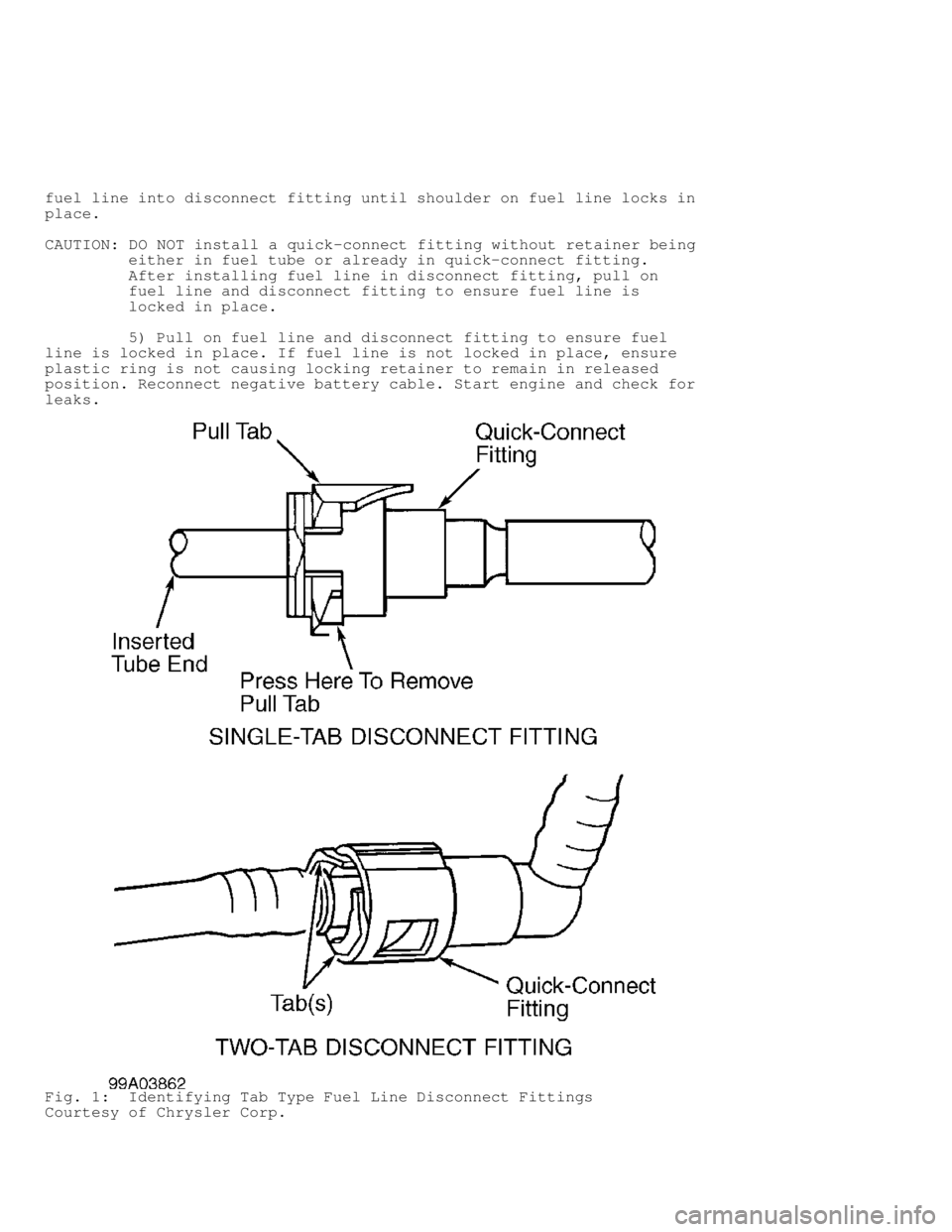
fuel line into disconnect fitting until shoulder on fuel line locks in
place.
CAUTION: DO NOT install a quick-connect fitting without retainer being
either in fuel tube or already in quick-connect fitting.
After installing fuel line in disconnect fitting, pull on
fuel line and disconnect fitting to ensure fuel line is
locked in place.
5) Pull on fuel line and disconnect fitting to ensure fuel
line is locked in place. If fuel line is not locked in place, ensure
plastic ring is not causing locking retainer to remain in released
position. Reconnect negative battery cable. Start engine and check for
leaks.
Fig. 1: Identifying Tab Type Fuel Line Disconnect Fittings
Courtesy of Chrysler Corp.
Page 634 of 1691
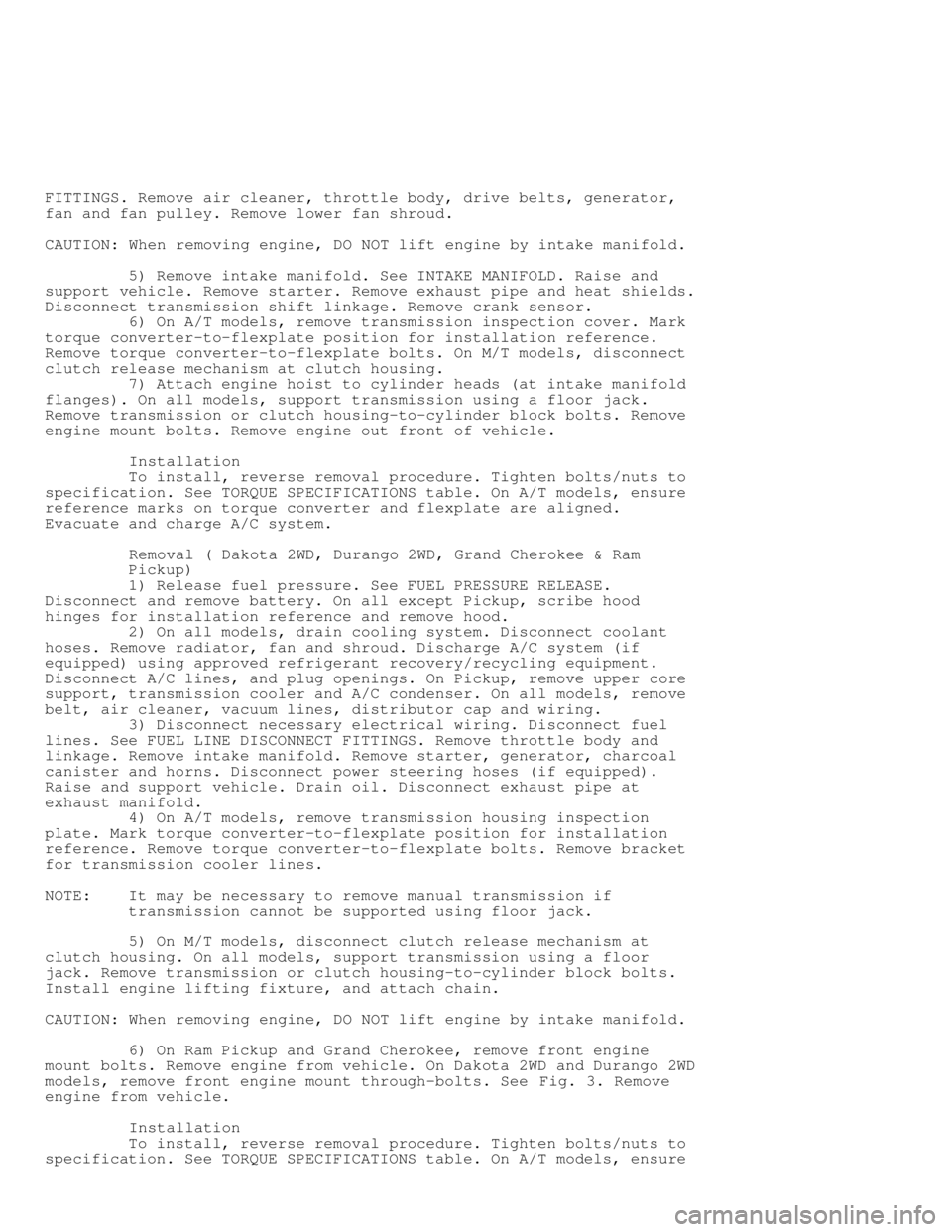
FITTINGS. Remove air cleaner, throttle body, drive belts, generator,
fan and fan pulley. Remove lower fan shroud.
CAUTION: When removing engine, DO NOT lift engine by intake manifold.
5) Remove intake manifold. See INTAKE MANIFOLD. Raise and
support vehicle. Remove starter. Remove exhaust pipe and heat shields.
Disconnect transmission shift linkage. Remove crank sensor.
6) On A/T models, remove transmission inspection cover. Mark
torque converter-to-flexplate position for installation reference.
Remove torque converter-to-flexplate bolts. On M/T models, disconnect
clutch release mechanism at clutch housing.
7) Attach engine hoist to cylinder heads (at intake manifold
flanges). On all models, support transmission using a floor jack.
Remove transmission or clutch housing-to-cylinder block bolts. Remove
engine mount bolts. Remove engine out front of vehicle.
Installation
To install, reverse removal procedure. Tighten bolts/nuts to
specification. See TORQUE SPECIFICATIONS table. On A/T models, ensure
reference marks on torque converter and flexplate are aligned.
Evacuate and charge A/C system.
Removal ( Dakota 2WD, Durango 2WD, Grand Cherokee & Ram
Pickup)
1) Release fuel pressure. See FUEL PRESSURE RELEASE.
Disconnect and remove battery. On all except Pickup, scribe hood
hinges for installation reference and remove hood.
2) On all models, drain cooling system. Disconnect coolant
hoses. Remove radiator, fan and shroud. Discharge A/C system (if
equipped) using approved refrigerant recovery/recycling equipment.
Disconnect A/C lines, and plug openings. On Pickup, remove upper core
support, transmission cooler and A/C condenser. On all models, remove
belt, air cleaner, vacuum lines, distributor cap and wiring.
3) Disconnect necessary electrical wiring. Disconnect fuel
lines. See FUEL LINE DISCONNECT FITTINGS. Remove throttle body and
linkage. Remove intake manifold. Remove starter, generator, charcoal
canister and horns. Disconnect power steering hoses (if equipped).
Raise and support vehicle. Drain oil. Disconnect exhaust pipe at
exhaust manifold.
4) On A/T models, remove transmission housing inspection
plate. Mark torque converter-to-flexplate position for installation
reference. Remove torque converter-to-flexplate bolts. Remove bracket
for transmission cooler lines.
NOTE: It may be necessary to remove manual transmission if
transmission cannot be supported using floor jack.
5) On M/T models, disconnect clutch release mechanism at
clutch housing. On all models, support transmission using a floor
jack. Remove transmission or clutch housing-to-cylinder block bolts.
Install engine lifting fixture, and attach chain.
CAUTION: When removing engine, DO NOT lift engine by intake manifold.
6) On Ram Pickup and Grand Cherokee, remove front engine
mount bolts. Remove engine from vehicle. On Dakota 2WD and Durango 2WD
models, remove front engine mount through-bolts. See Fig. 3. Remove
engine from vehicle.
Installation
To install, reverse removal procedure. Tighten bolts/nuts to
specification. See TORQUE SPECIFICATIONS table. On A/T models, ensure
Page 638 of 1691

Tighten bolts to specification, in steps, and in sequence. See Fig. 4.
See TORQUE SPECIFICATIONS table.
2) Install manifold flange gaskets on cylinder head with
MANIFOLD SIDE words visible. Place a 13/64" (5 mm) bead of silicone
rubber adhesive sealant at 4 corner joints. Install front and rear
gaskets. Ensure holes in front and rear gaskets engage with dowels in
cylinder block.
3) Install intake manifold and install all bolts finger
tight. Tighten bolts to specification, in steps, and in sequence. See
Figs. 5 and 6. See TORQUE SPECIFICATIONS table. To install remaining
components, reverse removal procedure.
Fig. 5: Intake Manifold Bolt Tightening Sequence (3.9L)
Courtesy of Chrysler Corp.
Page 643 of 1691
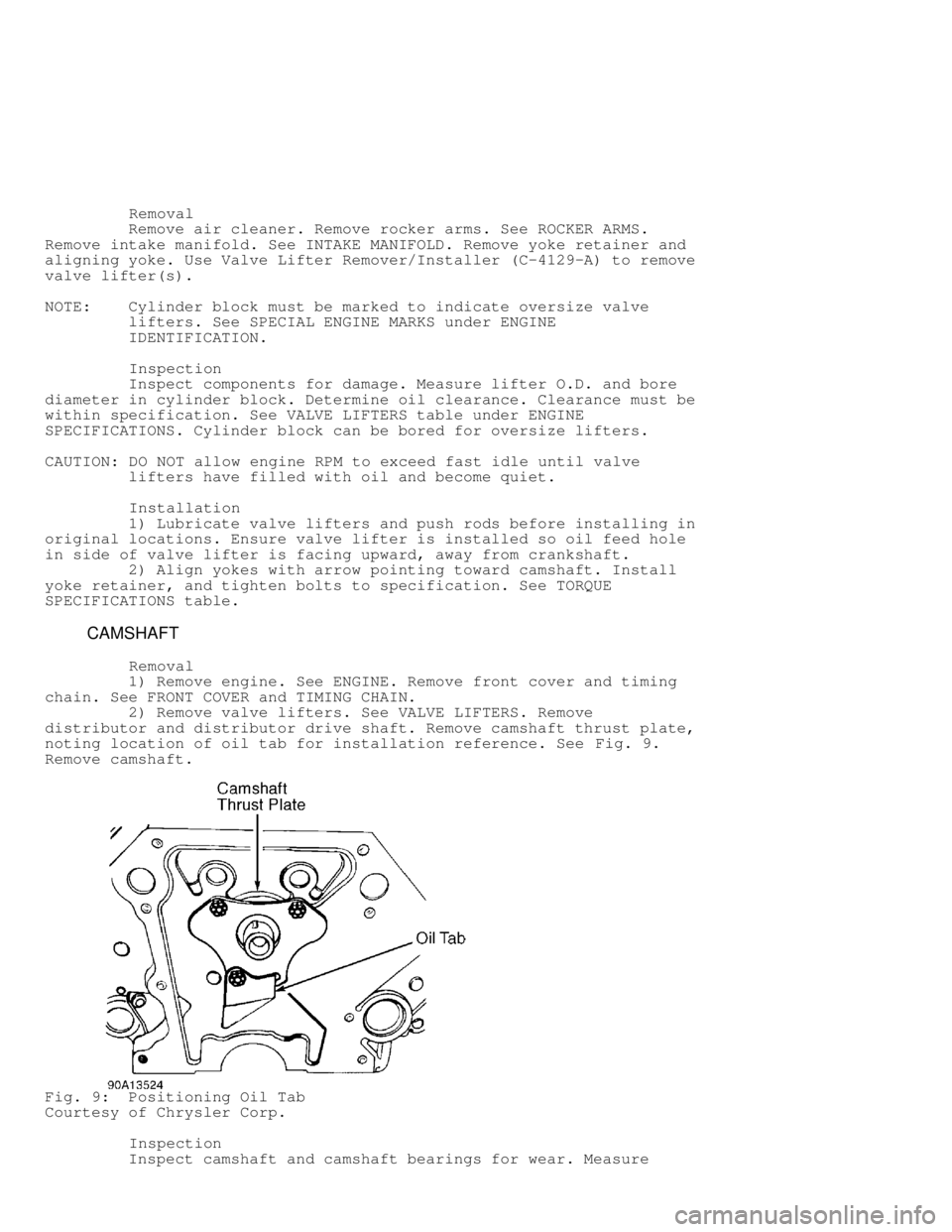
Removal
Remove air cleaner. Remove rocker arms. See ROCKER ARMS.
Remove intake manifold. See INTAKE MANIFOLD. Remove yoke retainer and
aligning yoke. Use Valve Lifter Remover/Installer (C-4129-A) to remove\
valve lifter(s).
NOTE: Cylinder block must be marked to indicate oversize valve
lifters. See SPECIAL ENGINE MARKS under ENGINE
IDENTIFICATION.
Inspection
Inspect components for damage. Measure lifter O.D. and bore
diameter in cylinder block. Determine oil clearance. Clearance must be
within specification. See VALVE LIFTERS table under ENGINE
SPECIFICATIONS. Cylinder block can be bored for oversize lifters.
CAUTION: DO NOT allow engine RPM to exceed fast idle until valve
lifters have filled with oil and become quiet.
Installation
1) Lubricate valve lifters and push rods before installing in
original locations. Ensure valve lifter is installed so oil feed hole
in side of valve lifter is facing upward, away from crankshaft.
2) Align yokes with arrow pointing toward camshaft. Install
yoke retainer, and tighten bolts to specification. See TORQUE
SPECIFICATIONS table.
CAMSHAFT
Removal
1) Remove engine. See ENGINE. Remove front cover and timing
chain. See FRONT COVER and TIMING CHAIN.
2) Remove valve lifters. See VALVE LIFTERS. Remove
distributor and distributor drive shaft. Remove camshaft thrust plate,
noting location of oil tab for installation reference. See Fig. 9.
Remove camshaft.
Fig. 9: Positioning Oil Tab
Courtesy of Chrysler Corp.
Inspection
Inspect camshaft and camshaft bearings for wear. Measure
Page 644 of 1691

camshaft journal diameter and camshaft bearing I.D. Replace camshaft
or camshaft bearings if not within specification. See CAMSHAFT table
under ENGINE SPECIFICATIONS.
CAUTION: If camshaft is replaced, valve lifters must also be replaced.
Whenever new camshaft or valve lifters are installed,
manufacturer recommends addition of one pint of Chrysler
crankcase conditioner to engine oil for at least 500 miles to
aid break-in.
Installation
1) Ensure cup plugs are installed in oil passages behind
thrust plate. Lubricate camshaft and bearings, and install within 2"
(50.8 mm) of final installation location.
2) Install Camshaft Installer (C-3509), with long area behin\
d
distributor drive gear. See Fig. 10. This prevents camshaft from
contacting plug located in rear of cylinder block. Install distributor
lock bolt to retain camshaft installer.
3) Install camshaft thrust plate and oil tab. Ensure tang
engages with lower right hole of camshaft thrust plate. Tighten
camshaft thrust plate bolts to specification. See TORQUE
SPECIFICATIONS table. Top edge of oil tab should be flat against
camshaft thrust plate for timing chain lubrication. See Fig. 9.
4) To install remaining components, reverse removal
procedure. Check camshaft end play. If end play exceeds specification,
replace thrust plate. See CAMSHAFT table under ENGINE SPECIFICATIONS.
Ensure components are installed in original location.
CAUTION: DO NOT allow engine RPM to exceed fast idle until valve
lifters have filled with oil and become quiet.
Fig. 10: Installing Camshaft
Courtesy of Chrysler Corp.
CAMSHAFT BEARINGS
Page 645 of 1691
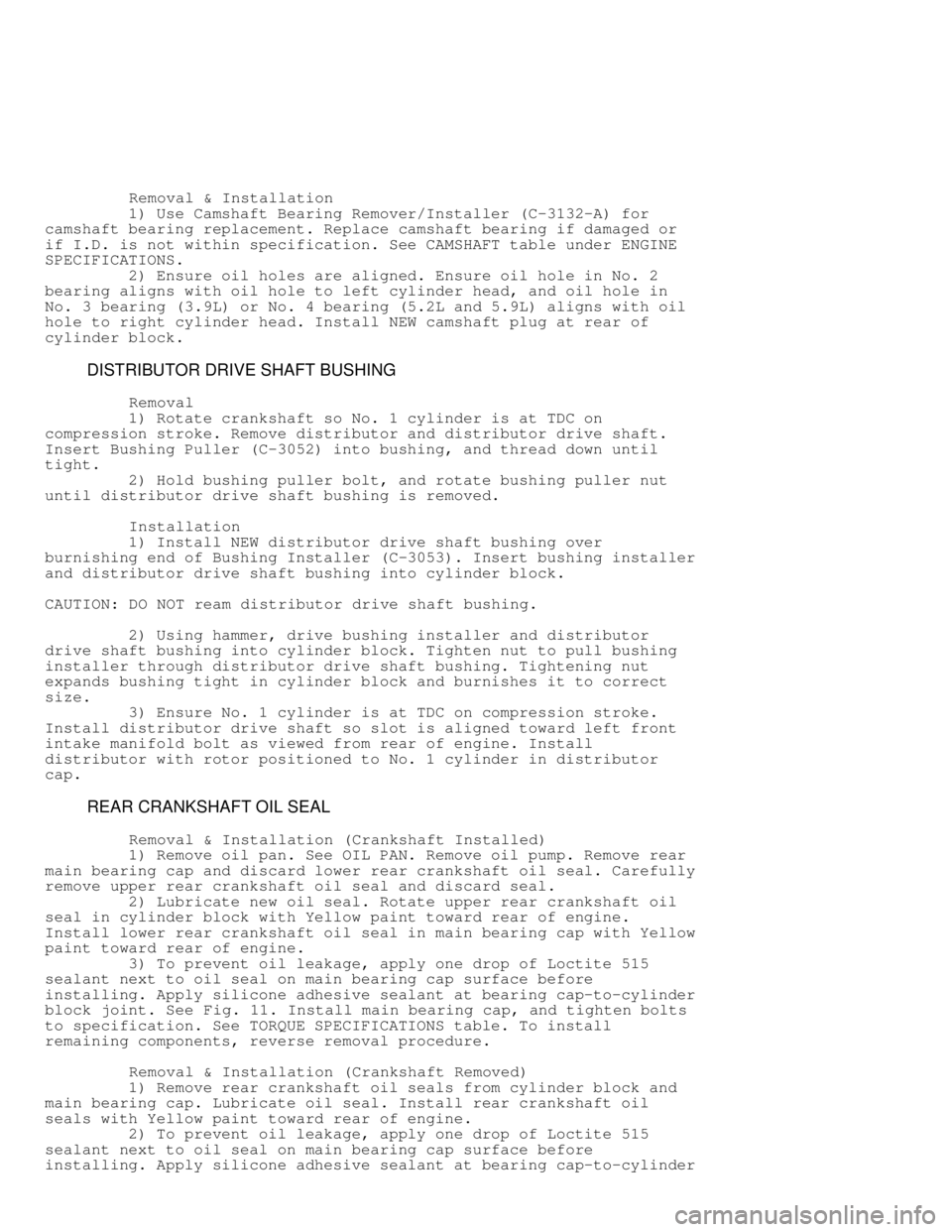
Removal & Installation
1) Use Camshaft Bearing Remover/Installer (C-3132-A) for
camshaft bearing replacement. Replace camshaft bearing if damaged or
if I.D. is not within specification. See CAMSHAFT table under ENGINE
SPECIFICATIONS.
2) Ensure oil holes are aligned. Ensure oil hole in No. 2
bearing aligns with oil hole to left cylinder head, and oil hole in
No. 3 bearing (3.9L) or No. 4 bearing (5.2L and 5.9L) aligns with oi\
l
hole to right cylinder head. Install NEW camshaft plug at rear of
cylinder block.
DISTRIBUTOR DRIVE SHAFT BUSHING
Removal
1) Rotate crankshaft so No. 1 cylinder is at TDC on
compression stroke. Remove distributor and distributor drive shaft.
Insert Bushing Puller (C-3052) into bushing, and thread down until
tight.
2) Hold bushing puller bolt, and rotate bushing puller nut
until distributor drive shaft bushing is removed.
Installation
1) Install NEW distributor drive shaft bushing over
burnishing end of Bushing Installer (C-3053). Insert bushing installer\
and distributor drive shaft bushing into cylinder block.
CAUTION: DO NOT ream distributor drive shaft bushing.
2) Using hammer, drive bushing installer and distributor
drive shaft bushing into cylinder block. Tighten nut to pull bushing
installer through distributor drive shaft bushing. Tightening nut
expands bushing tight in cylinder block and burnishes it to correct
size.
3) Ensure No. 1 cylinder is at TDC on compression stroke.
Install distributor drive shaft so slot is aligned toward left front
intake manifold bolt as viewed from rear of engine. Install
distributor with rotor positioned to No. 1 cylinder in distributor
cap.
REAR CRANKSHAFT OIL SEAL
Removal & Installation (Crankshaft Installed)
1) Remove oil pan. See OIL PAN. Remove oil pump. Remove rear
main bearing cap and discard lower rear crankshaft oil seal. Carefully
remove upper rear crankshaft oil seal and discard seal.
2) Lubricate new oil seal. Rotate upper rear crankshaft oil
seal in cylinder block with Yellow paint toward rear of engine.
Install lower rear crankshaft oil seal in main bearing cap with Yellow
paint toward rear of engine.
3) To prevent oil leakage, apply one drop of Loctite 515
sealant next to oil seal on main bearing cap surface before
installing. Apply silicone adhesive sealant at bearing cap-to-cylinder
block joint. See Fig. 11. Install main bearing cap, and tighten bolts
to specification. See TORQUE SPECIFICATIONS table. To install
remaining components, reverse removal procedure.
Removal & Installation (Crankshaft Removed)
1) Remove rear crankshaft oil seals from cylinder block and
main bearing cap. Lubricate oil seal. Install rear crankshaft oil
seals with Yellow paint toward rear of engine.
2) To prevent oil leakage, apply one drop of Loctite 515
sealant next to oil seal on main bearing cap surface before
installing. Apply silicone adhesive sealant at bearing cap-to-cylinder